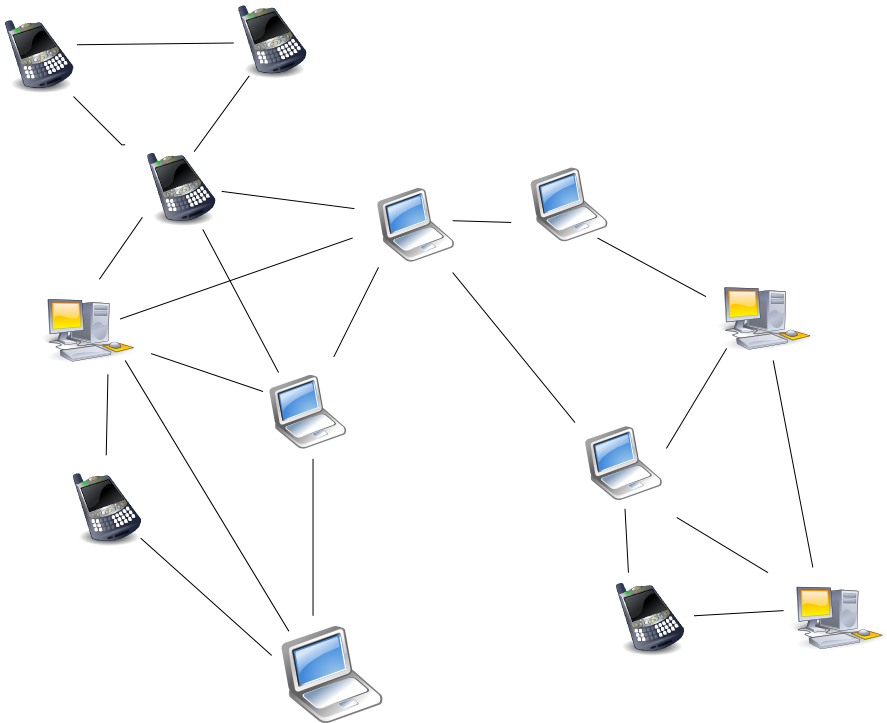I recently had the privilege to attend Meshing with Data 2018 in Bayamón. Universidad de Puerto Rico invited us to mentor groups of hackers at a hackathon focused on mesh networking, disaster response, and the aftermath of hurricane María last year.
Mesh networking
For those not familiar with the term “mesh networking”, it’s a network topology that dispenses with traditional network traffic aggregators like dedicated routers or switches. An ideal mesh network would be entirely composed of end-user devices (like cell phones) connecting directly to each other with bluetooth or wi-fi and organizing the flow of traffic among themselves.
If you would like to do some research, there are established and developing technologies in this space: goTenna, MeshKit, and hiro-net to name a few.

Ready to learn
This was a unique chance for Ushahidi to learn. I was looking forward to listening to the experiences of people during the hurricane. My other hope was to engage in conversation, seeking ways crowdsourcing technology like Ushahidi Platform can help in the next hurricane season.
The Ushahidi Platform has been used for the last 10 years to successfully assist the response to natural disasters in places like Haiti, Japan or Nepal, to name a few. I did my best to research and present some of the success factors and challenges that we learned from these events.
It was after my presentation that I was able to hear the stories and participate in the conversations I was hoping for.
Puerto Ricans’ Experiences
Most of us have heard that Puerto Rico experienced a long lasting power outage at the time of hurricane Maria. The participants in Bayamon spoke about how a nearly complete communications blackout made coordinating response so difficult.
The cellular network was not functioning for the majority of the islanders, and the same happened to any other form of internet access. The few people that had landlines could rarely use them. For most, the only remaining means of communication was AM radio. Islanders sometimes drove up (or walked) to radio stations in order to personally relay their messages in emergency broadcasts.
The diaspora of Puerto Ricans living outside the island was able to gather in chat rooms and organise help. Some of that help went to critical efforts, such as ensuring that electricity generators in key facilities would receive fuel and local grids could cover basic emergency needs. However, their work was severely hampered by patchy communication. It would usually take several days to receive any sort of news or feedback from people in the island.
No one expected the island’s infrastructure to be hit the way it was, and I could sense the determination in the room to be ready for the next big emergency. Students and enthusiasts were hacking the tech could help in the next crisis for Puerto Ricans. For example, some of the local professors were already imagining ways to engage their students to run projects on the Ushahidi Platform, which they had just learned about.
What does this mean for crisis response?
After learning more about how many Puerto Ricans didn’t expect the impact of Maria to be so immense, I think that we at Ushahidi need to do more to prepare our Platform to work in a disaster scenario like the one they described. In a place with prevalent lack of internet access or SMS service, it would be very difficult for the population to send reports to Ushahidi, and even harder to co-ordinate a response.
We are learning from the work being done in Puerto Rico, and we’re exploring more opportunities to integrate mesh networks into the platform. We need to keep looking out for those use cases that challenge our assumptions and where neither SMS nor stable, reliable internet are available. These can be extremely valuable, not only in Puerto Rico but in many other places where connectivity is a challenge.
I left feeling excited about new opportunities, as well as new tools and technology. With any luck, I’ll be writing about it here again soon!
For that chance, for the conversations, and for the invitation, I would like to thank the organisers, Obsidis Consortia, our contacts at the Universidad de Puerto Rico, our community members who put us in contact with the organisers, and all the people I had the pleasure to meet.
Gracias, Puerto Rico.